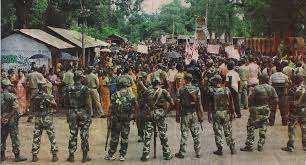Perhaps no ideology in the world is as controversial, barbaric, and undemocratic as communist ideology

Niraj Krishna
The news of the martyrdom of 3 soldiers and injuries to 15 in a Naxal attack in Sukma, Chhattisgarh, two days ago has shaken the entire country. Meanwhile, the question is also swirling in the minds of the common people as to why the governments have not been entirely successful in eradicating this problem from its roots. In the past few years, during these Naxal attacks, hundreds of deaths have occurred, revealing that Naxalism is not just an issue of the country’s internal security and law enforcement but also a complex social problem intertwined with political and economic issues.
Naxalism is primarily prevalent in the regions of the Vindhya range. The crucial aspect is that the supporters of the Naxal movement are predominantly tribal and Dalit. In India, Dalits and Adivasis, together representing a quarter of the population, not only face unprecedented backwardness but also depend on their livelihoods on free natural resources. However, with the arrival of the British and the enactment of forest laws, Adivasis were displaced from their forest areas due to their traditional livelihood practices, and this trend continued consistently. Adivasis, displaced from their regions, were forced to move to other places.
I hope that most people have not forgotten the massacres in Sukma (Chhattisgarh) such as the killing of 27 people, including the architect of Salwa Judum, Mahendra Karma, and the Congress chief of Chhattisgarh, Nand Kumar Patel, and the murder of 11 CRPF soldiers by Naxals in March 2017, and the killing of 22 soldiers in a Naxal attack in Sukma in April 2021. Forgetting such incidents is a dangerous ailment prevalent in our country. The question arises about what our government is doing while more than half of the states in our country are severely affected by Naxalism, but the government seems indifferent to the issue.
The inception of Naxalism can truly be traced back to the principles of class struggle laid out by Karl Marx. In 1967, it began in the Naxalbari village of the Darjeeling district in West Bengal. While initially centered around land disputes, though marked by violent activities and tension, the roots of the conflict ran deep. Gradually, this movement intensified, adopting violence as its form of expression.
Naxalism is fundamentally a legal issue, or rather, it is the erupting lava from the volcano of inequality. While one class of intellectuals associates it with activities akin to terrorism, considering it the greatest threat to the nation’s internal security, the leftist perspective sees it as a simple rebellion born out of social, economic, political disparities, exploitation, and the agony of injustice, taking a strong stance in its favor.
Perhaps no ideology in the world is as controversial, barbaric, and undemocratic as communist ideology. Communist ideology has consistently worked against India and Indianness. In recent decades, Naxalites have emerged as the biggest threat to India’s internal security. Around the 1960s, Naxalism took root in Bengal, and at that time, Congress, led by Siddhartha Shankar Ray, took stringent measures to eliminate Naxalism.
If we look at the history of Naxals, there may not be a single year where Naxal organizations have not committed large-scale killings of security forces and civilians. In this context, the question arises: instead of addressing the reasons behind Naxalism, have political parties fueled it? The question also arises: what steps has the government taken to deal with it? If the government’s steps are not in the right direction, what is the correct solution to this problem? The question also arises: are our security forces equipped with the technology to effectively deal with this problem? Or is there a lack of political will in our governments? ‘Naxalism’ has become the biggest obstacle to the country’s development path.
The failure to find a solution to the Naxal problem can be attributed to two main reasons. Firstly, there is a lack of consensus within political parties on whether this issue is a socio-economic problem or a law and order issue. Secondly, the economics behind it raises questions. While the central and state governments allocate considerable funds to every Naxal-affected district, there is no accountability for how and where this money is spent. It is evident that these funds are being distributed among politicians, officers, and contractors. Unless this economic puzzle is unraveled and responsibility is established, finding a solution may remain elusive.
Today, our policing system has become ineffective, leading to Naxal-like parallel governments in many states. Most criminals don’t inherently become criminals; they are driven to pick up arms due to the extreme atrocities inflicted upon them. Those marginalized by society are often the outcome of Naxalism. Unfortunately, Naxalism has taken such a twisted form that it has detached itself from the common people, for whom this movement was initially initiated. Now, it has transformed into mere terrorism, demanding stringent measures. However, it seems that those who reap political benefits do not want this issue to be resolved, as it might lead these individuals to merge into the mainstream of the nation.
What can be said about the bloody game of Naxals that has been ongoing for decades? Whether it’s seen as a struggle for freedom or as a defense mechanism against their violent actions, the result is the same—escalated anger fueled by the double standards of development and police brutality. It cannot be denied that in some Naxal-affected areas, the pace of development is extremely slow. However, the pace of development is sluggish across various parts of the country where poverty, hunger, and helplessness prevail. Should people in those areas also attempt development through the force of arms, our entire nation will fall prey to internal conflict. Development cannot be brought about by the force of arms, and weapons are not the root cause of any problem. The biggest culprits are our leaders and our government, which first allow issues like Naxalism to fester and then, when it becomes a monster, calmly bury their heads in the sand like an ostrich.
In conclusion, addressing the Naxal issue requires a multifaceted approach, including political consensus, economic transparency, and a focus on grassroots development. Until these issues are addressed, the specter of Naxalism will continue to haunt our nation.


